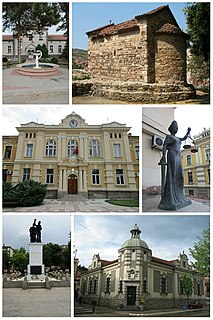 W
WBela Reka is a village in Šabac, Serbia.
 W
WGamzigrad is an archaeological site, spa resort and UNESCO World Heritage Site of Serbia, located south of the Danube river, in the city of Zaječar. It is the location of the ancient Roman complex of palaces and temples Felix Romuliana, built by Emperor Galerius in Dacia Ripensis. The main area covers 10 acres (40,000 m2).
 W
WKoviljkin grad or Koviljka is a name for archaeological ruins close to Banja Koviljača in the Loznica district of western Serbia. The ruins are of a Roman town, which may have been named Gensis; the name has never been confirmed. It is located on the top of a hill, and the remains of the walls spread about 150 metres around it.
 W
WKraku Lu Jordan is archeological site in Serbia. It is situated at the confluence of the Brodica river into Pek, near Kučevo. Represents the most explored metallurgical center in eastern Serbia. The metallurgic occupation of the site lasted for about 100 years, beginning around 280 AD and ending in 380 AD. Kraku Lu Jordan is precisely dated by discovered coins from Diocletian time. This metallurgical complex was then destroyed in a fire in the late 4th century. Archaeological excavations began in 1971, and with few interruptions, lasted until 1987.
 W
WThe Pannonian Limes is that part of the old Roman fortified frontier known as the Danubian Limes that runs for approximately 420 km (260 mi) from the Roman camp of Klosterneuburg in the Vienna Basin in Austria to the castrum in Singidunum (Belgrade) in present-day Serbia. The garrisons of these camps protected the Pannonian provinces against attacks from the north from the time of Augustus (31 BC-14 AD) to the beginning of the 5th century. In places this section of the Roman limes also crossed the river into the territory of the barbarians (Barbaricum).
 W
WProkuplje is a city and the administrative center of the Toplica District in southern Serbia. According to 2011 census, the city urban area has a population of 27,333 inhabitants, while the administrative area has 44,419 inhabitants.
 W
WThe Roman Emperors Route is a tourism and archaeology project in Serbia, a route spanning 600 km with several ancient Roman sites, among which are notable cities, estates and birthplaces. The project's name is derived from the fact that 17 Roman emperors were born within the current borders of Serbia, the second country after Italy itself. The sites include the important Roman cities of Sirmium, Felix Romuliana and Naissus. The project is regarded as one of the largest archeological and tourism projects in Serbia, and the project board is guided and financed by the Serbian Ministry of Economy and Regional Development and Ministry of Culture. It is regarded as one of the national brands of Serbia.
 W
WTrajan's Bridge, also called Bridge of Apollodorus over the Danube, was a Roman segmental arch bridge, the first bridge to be built over the lower Danube and one of the greatest achievements in Roman architecture. Though it was only functional for 165 years, it is often considered to be the longest arch bridge in both total and span length for more than 1,000 years.
 W
WVia Militaris or Via Diagonalis was an ancient Roman road, starting from Singidunum, passing by Danube coast to Viminacium, through Naissus, Serdica, Philippopolis, Adrianopolis, and reaching Constantinople. This road was connected with Via Egnatia by other roads - the road along river Axios, the Serdica–Thessalonica road along river Strymon, and the road Philippopolis–Philippi.
 W
WŠarkamen is a settlement situated in eastern Serbia, in the Negotin municipality of the Bor District. It is inhabited by 369 people, with a Serb majority (98,66%)
 W
WŽrnov or Žrnovan (Жрнован) was a medieval fortress on the highest top of the Avala Mountain, at 511 metres (1,677 ft), in Belgrade, Serbia. At the top Ancient Romans built an outpost, and later the Serbs expanded it into a fortress. It was completely demolished in 1934 to make the way to the Monument to the Unknown Hero.